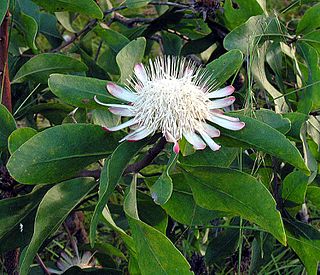
Protea gaguedi is a species of tree which belongs to the genus Protea.

Protea welwitschii is a species of shrub or small tree which belongs to the genus Protea, and which occurs in bushveld and different types of grassland.

Protea laurifolia, also known as the grey-leaf sugarbush, is a shrub from South Africa. It is native to the Cape Provinces of South Africa.

Protea aristata is a compact shrub with beautiful flowers which is endemic to the southwestern part of the Cape Region of South Africa. P. aristata has become one of South Africa's most famous proteas in spite of its relatively late discovery, and re-discovery in 1953. The leaves are soft, dense and needle-like and the flower heads are a stunning crimson red, it may thus be a good potential ornamental plant for South African gardens. It is usually called the Ladismith sugarbush in South African English, although it has been called pine sugar bush in Australia. In the Afrikaans language it has the vernacular name of klein-den-suikerbos.

Protea magnifica, commonly known as the queen protea, is a shrub, which belongs to the genus Protea within the family Proteaceae, and which is native to South Africa.

Protea effusa, sometimes known as the scarlet sugarbush, is a flowering plant which belongs to the genus Protea. The plant is endemic to the Western Cape province of South Africa. In the Afrikaans language the vernacular name blosrooisuikerbos has been recorded for this plant.

Protea pendula, also known as the nodding sugarbush or arid sugarbush, is a flowering plant of the genus Protea, in the family Proteaceae, which is only found growing in the wild in the Cape Region of South Africa. In the Afrikaans language it is known as knikkopsuikerbossie or ondersteboknopprotea.

Protea sulphurea, also known as the sulphur sugarbush, is a flowering plant of the genus Protea in the family Proteaceae, which is only known to grow in the wild in the Western Cape province of South Africa. A vernacular name for the plant in the Afrikaans language is heuningkoeksuikerbos or Skaamblom.

Protea foliosa, also known as the leafy sugarbush, is a flowering plant of the genus Protea in the family Proteaceae which is endemic to the Cape Region of South Africa. In the Afrikaans language it is known as ruie-suikerbos.

Protea intonsa, also known as the tufted sugarbush, is a flowering plant of the genus Protea within the family Proteaceae, endemic to South Africa, where it is distributed from the eastern Swartberg and Kammanassie Mountains to the Baviaanskloof mountains. In Afrikaans it is known as klossie-suikerbos.
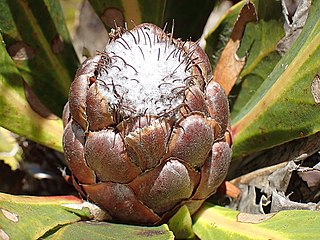
Protea vogtsiae, also known as the Kouga sugarbush, is a small flowering shrub of the genus Protea within the family Proteaceae, which is only found growing in the wild in the southern Cape Region of South Africa.
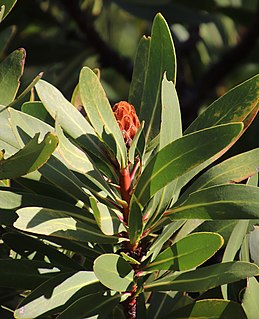
Protea rubropilosa, also known as the Transvaal sugarbush, escarpment sugarbush or Transvaal mountain sugarbush, is a flowering tree, that belongs to the genus Protea in the family Proteaceae. The plant only occurs in South Africa.

Protea dracomontana, the Nyanga protea or the Drakensberg sugarbush, is a flowering plant that belongs within the genus Protea. The plant is found in the Eastern Cape, Lesotho, KwaZulu-Natal and the escarpment of the Free State, as well as eastern Zimbabwe. In Zimbabwe this species is only known from a disjunct subpopulation confined to the summit of Mount Nyangani.

Protea pudens, also known as the bashful sugarbush, is a low-growing, groundcover-like, flowering shrub in the genus Protea. It is only found growing in the wild in a small area in the Western Cape province of South Africa.
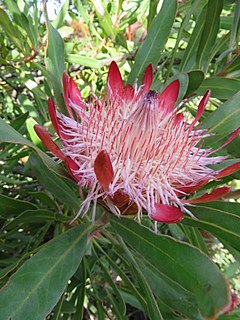
Protea susannae, also known as stink-leaf sugarbush, is a flower-bearing shrub of the genus Protea. The plant is endemic to the southwestern Cape Region of South Africa.

Protea angustata, also known as the Kleinmond sugarbush, is a flowering shrub that belongs to the genus Protea. This plant is endemic to the south-west Cape Region of South Africa.
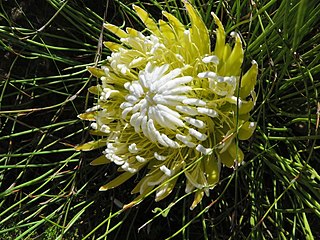
Protea lorea, also known as the thong-leaf sugarbush, is a flowering shrub belonging to the genus Protea.

Protea lorifolia, in English called the strap-leaved sugarbush, strap-leaved protea or strap-leaf sugarbush is a flowering shrub which belongs to the genus Protea.

Protea caespitosa, also known as hottentot bishop sugarbush or bishop sugarbush, is a flowering shrub belonging to the genus Protea which is only found growing in the wild in South Africa.

Protea punctata, also known as the water sugarbush or water white sugarbush, is a shrub belonging to the genus Protea which is found growing in the wild in South Africa.





















